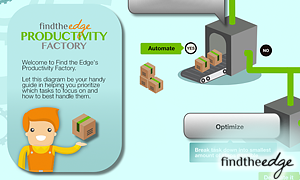 The words ‘objection handling' are searched on Google 6,600 times per month. This area of sales is clearly a major problem for many businesses and individuals.
The words ‘objection handling' are searched on Google 6,600 times per month. This area of sales is clearly a major problem for many businesses and individuals.
In this article, I will share with you the single best response I have ever come across for handling objections but, just before I do, I want to explain how you can help to PREVENT the objection from happening in the first place.
Buying Signals
One of the biggest errors I see businesses making is being too quick to think a prospect is going to buy. They misinterpret something for a buying signal.
The classic example is when somebody asks for a quote or a proposal.
When we are asked to put something in writing, we have an instinctive tendency to think that the prospect WANTS or NEEDS either our product, or our competitors’ product.
The assumption is that either we, or one of our competitors, will get the deal.
This is a major error. Almost half of individuals and businesses who ask for a quote never place an order with anybody! They stick with their current situation, whatever that is.
Another major error is in not appreciating the fact that selling to a WANT requires totally different sales techniques to selling to a NEED.
The ‘buying process' individuals and companies go through when they decide they WANT a product or service is totally different to the one they go through where they NEED a product.
OK – now the biggest mistake of all is to think the prospect has reached the point where they either WANT or NEED a product.
Even if you are not sure about the different sales techniques required to sell to these two types of buying motive, it makes no difference if you are trying to sell to people who have not even reached the WANT or NEED stage of the buying process.
In my book ‘The Cold Calling Secret' I have a whole chapter dedicated to the ‘buying process', and I talk about the huge differences between how a WANT and a NEED arise, and therefore how we need to sell to them differently.
I also explain the four stages of the buying process, and how we go through two other stages before we have a WANT or a NEED.
The second stage is where we have an INTEREST in a product or service.
This is the key to the problem I am describing. We all get to a point where we are INTERESTED in a product or service BEFORE we decide we either WANT or NEED it.
INTEREST alone is not enough of a motive to buy. We can be very interested but still not buy – and guess what happens when we get interested? Yes, we often ask for a quote.
So being asked for a quote only ever tells you that the prospect is indeed INTERESTED in a product.
It requires more qualification to establish if they have surpassed that point in the buying process, and actually WANT or NEED a product. They could well have at that point, but how do you know?
How can you tell if a prospect really WANTS or NEEDS a product (and will therefore definitely buy off either you or somebody else) or if they are still just INTERESTED?
Well that’s for another article. For now, let’s assume you have a request for a proposal.
If you get sales objections after you have made your proposal please note that if the prospect is still in the INTERESTED stage of the buying process then the objections you get are usually FALSE.
Most people (even trained buyers) don’t like to give people bad news. They would rather let you down politely and slowly.
So, they offer up countless reasons why they are not ready to make a decision, or why they have to ‘think about it'.
Most salespeople’s pipelines are cram packed full of prospects like this, and they take up over 60% of a salesperson's time chasing, proposal writing, presenting etc… only to come to nothing.
I train businesses to prevent this from happening by getting a complete understanding of where the prospect is in the buying process. If you can establish that, then you can sort the wheat from the chaff, and focus more of your attention on two things:
- Using sales techniques to get your prospect from INTERESTED to the next stage. This will mean they will at least ORDER off either you or a competitor.
- If they are not going to get to the next stage of the buying process with your techniques from the first step, politely dropping them from your pipeline is wise. This is not easy to do. Most of us would rather keep our diaries and days full and ‘hang on' to every sales opportunity. However, every hour you spend on an INTERESTED prospect that ultimately never buys is wasted, and could have been spent selling to one that is going to buy.
Once you are dealing primarily with prospects that ARE eventually going to buy, then your next huge task is to make sure that they buy from you, and that is where you use specific sales techniques to DIFFERENTIATE yourself from the competition.
To do this, you need to RESET the prospect’s buying criteria so that he can only buy from you (which is a large subject in its own right).
However, if we assume that you are now dealing with a prospect that does either WANT or NEED a product, but they haven’t decided whether it is going to be yours, or your competitors – and you get a sales objection – then in my experience the best way to deal with this is to…
AGREE WITH IT!!!
I can hear a gasp… ‘Agree with an objection,' you are saying. Why would anyone do that?
The answer is too long for this article, but studies show that when you agree with something somebody says in ‘opposition' to your stance – and then offer a ‘reason' as to why you are agreeing – the person who is in ‘opposition' will psychologically become ‘neutralised' and open to a NEW suggestion by you.
I have a full sales training module that teaches persuasion techniques, and some of them are very powerful. This is one of them.
Let me give you an example of it in action:
Let’s take the classic example of ‘it’s too expensive' or ‘it’s out of my budget.'
A response to this ‘objection' could be:
“OK Mr Prospect, I can understand why you might think that, in fact, most of my customers initially thought that when they first read my proposal. However – once we broke the proposal down and looked at the value the ‘product/service' is giving, they started to see why it makes sense. So let’s have a quick look at the proposal I sent you and break it down to see if it makes sense for you.”
In this example, I have AGREED with the prospect, and then given a ‘reason' for my agreement… followed by a NEW suggestion – which is to have a look at the proposal and break it down. This can then lead to a new discussion and an opportunity to justify the price.
I call this the ‘Disarming' technique, because when you agree with someone who is in ‘opposition,' you effectively disarm them of their opposing view.
It can be used at all stages of the sales cycle – not just towards the end when you get objections like the example above.
This technique is not a magic bullet, but it is very powerful at ‘reframing' an objection so you can re-establish your position with the prospect.
I must stress here that if you do the following three things…
- Make sure the prospect is at the third stage of the buying process and DOES either want or need a product.
- Establish the ‘buying criteria' and make sure you have ‘reset' it.
- Involved the decision maker AND the Key Decision Maker (there are ALWAYS at least two people involved in decision, and most salespeople don’t have a dialogue with the Key Decision Maker}.
…then you will encounter far fewer sales objections.
There are many other sales techniques you can use to PREVENT objections, but if you focus on those in this article, you will reduce them dramatically. When you do get an objection, you can then use the ‘disarming' technique to ‘reframe' your position and move forward.
Remember – we are ALL selling, all of the time, so it pays to be trained in sales!





